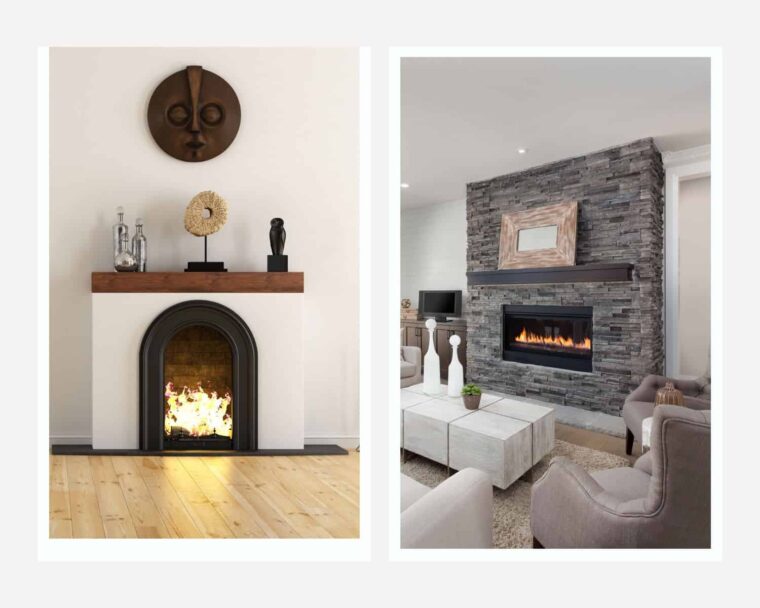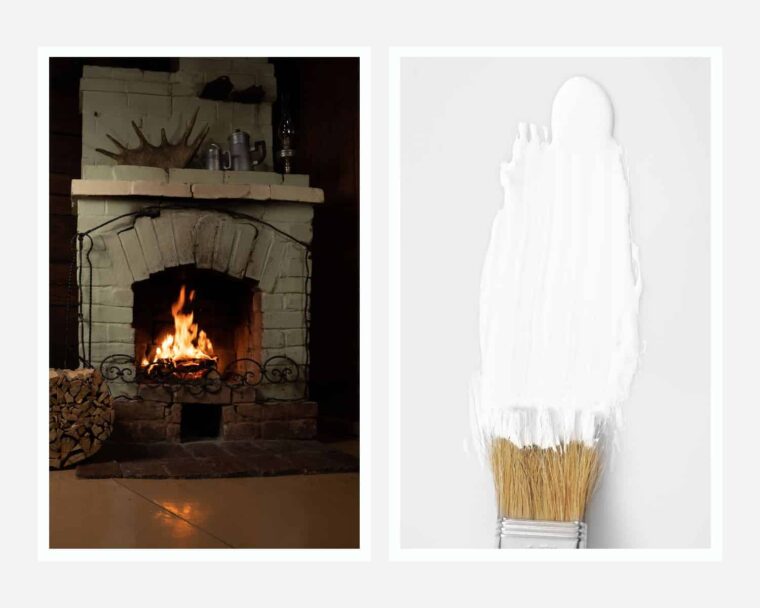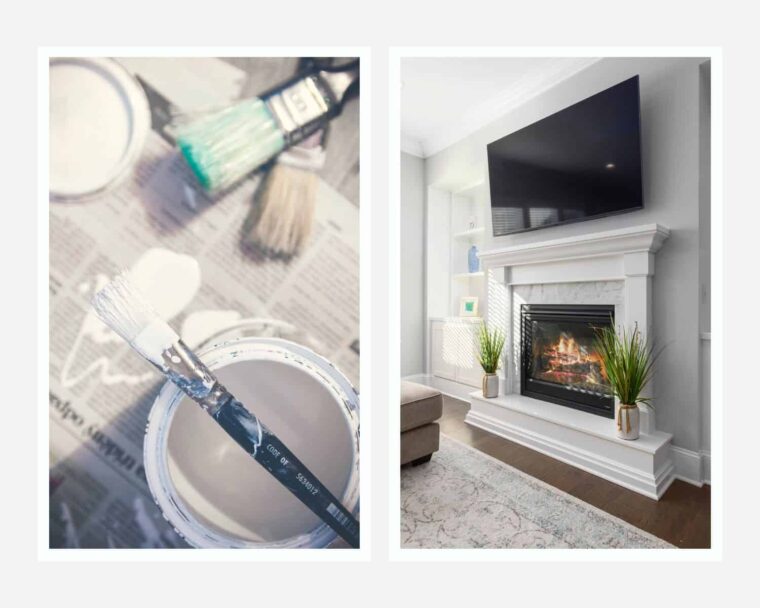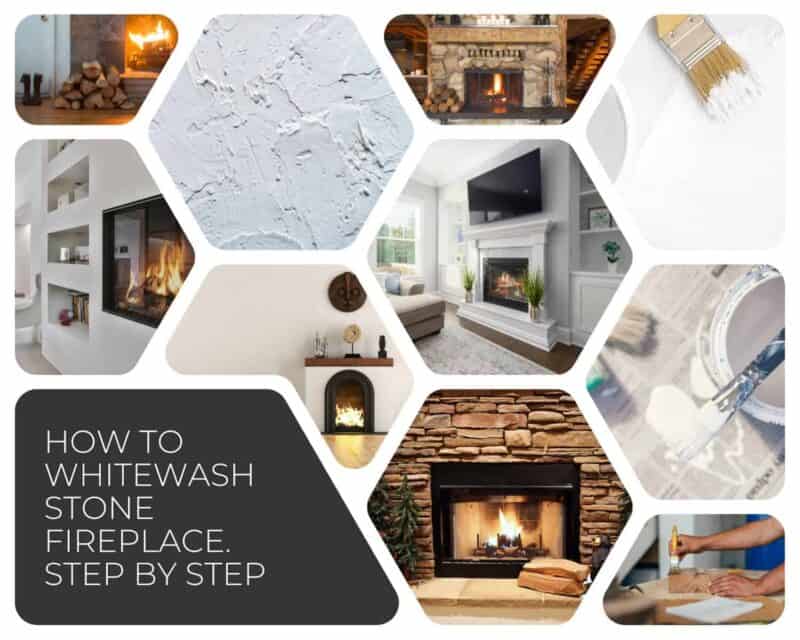It’s time to update your fireplace, and you’re looking for ways to make it look new again. Maybe you want something that blends in with the rest of the room, or you just want a cleaner look for your home.
There are many options, but one of the easiest ways to give it an update is whitewashing your stone fireplace. It can be done quickly and easily without worrying about damage from tools or paint fumes. You may also want to consider using semi-transparent paint on a gray or light gray surface so that it doesn’t overwhelm the room color scheme.

What to Consider Before You Whitewash a Stone Fireplace
The most crucial step when whitewashing your stone fireplace is ensuring you do the right thing and have suitable materials. Here are some considerations to make:
- Decide whether you want to paint or refinish: Before starting a project, you must decide whether to paint your stone fireplace or refinish it. If you are doing the latter, you must understand the difference between staining and painting.
- Type of paint: Painting involves covering the stone with a thin layer of paint, which is then sealed to protect the surface from water damage. Staining uses a special type of paint formulated specifically for stone surfaces. This type of paint contains pigments more resistant to chipping and cracking than traditional paints.
- Time and Effort: If you choose to stain your fireplace, you must consider how much time and effort go into preparing the surface before applying staining solutions. Ensure all surfaces have been thoroughly cleaned and maintained so they are free from dirt or grime before applying stains.
- Type of stone: Another thing to consider is the type of stone fireplace you want to whitewash. To use paint, you must choose a paint designed for stonework. Some paints can be used on any type of stone, but others are specifically designed for stonework.
- Whether your fireplace needs repair or maintenance: The last thing to consider is whether or not your fireplace needs repair or maintenance. If so, then some companies offer this service for a fee. You can also call around until you find one that offers the service at an affordable price.
Choosing The Right Paint
As seen, choosing the right paint is a very important step in whitewashing your stone fireplace. Here are some tips to help you:
Price
The price is the first thing to consider when you’re looking for paint to whitewash a stone fireplace. The good news is that many great options are available at affordable prices. Many of them have been designed specifically for this application and have received great customer reviews.
Brand
The next thing you’ll want to look into is the brand of paint that you choose. There are several different brands, and they each have unique characteristics. Some are more environmentally friendly than others, so it pays to do your research if you want to go green with your choice of paints.
Functionality
While function is important, it is not as important as the question of whether the paint will work with the existing stone color in your fireplace. If you have a marble or limestone hearth, you may want to consider using paint that matches your stone. If you have granite or other more modern stone, you will probably want to use exterior latex paint designed to look like natural stone.
Customer Consensus
Finally, customer consensus is important in choosing the right product for your needs. Suppose there’s a lot of positive feedback about a particular paint or stain. In that case, that’s probably something you want to keep in mind before deciding what kind of product might work best for your situation!

Create Your Whitewash Mixture
When you’ve decided what you want to do with your fireplace and have the right paint, you can then create a whitewash mixture.
What You Need
- Stain Pads: You can find these in the paint department at your local hardware store or home center. They come in different colors and patterns, so you can find one that works best for the look you are going for.
- Paint Brushes: You need a brush with bristles that are stiff enough to apply the whitewash but not so stiff that they will crack your surface. The brushes should be long enough to reach all of your pots, pans, and other items without having to bend over too much.
- Chalk Style Paint: This is the most expensive part of this project, but it is also quite simple if you can access some chalk-style paint at home. This type of paint comes in various colors, including whites, blacks, and grays. It is thin, so it dries quickly and doesn’t leave behind any residue when it sets on your surface.
- Water: You need water to make the whitewash mixture and dilute the paint. You can use a garden hose or fill a bucket with water and let it sit overnight. If you use warm water, it can cause paint bubbles on the surface.
- Towel: You will need a clean towel to wipe off your brushes when they are finished painting so that they don’t leave behind any paint in your work area. Also, it would be best if you used this same towel to wipe off any excess paint from your brush after each stroke of paint on your canvas or paper.
- Work Glasses and Gloves: When mixing up your whitewash mixture, use safety glasses and rubber gloves. You don’t want harmful chemicals getting into your eyes or skin if there is any accidental splash-back from mixing up the paint too quickly or unevenly (such as when mixing some of it with water).
Steps to Step Directions
When you have all the materials you need, you can follow these guides on whitewashing the fireplace.
Clean your stone with warm soapy water
The first step to whitewashing your stone fireplace is to clean it with warm soapy water. You may want to use a sponge and gentle soap, like Dawn or Palmolive, but if you have time on your hands (or if you’re feeling extra ambitious), try using a mild abrasive cleaner such as toothpaste instead of the soft bristles of the washcloth.
Once you’ve scrubbed away all of the grime from your fireplace, rinse any residue thoroughly with clear water and dry off any remaining dirt or dust on its surface before moving on to Step 2.

Create your whitewash mixture:
If you’re new to painting, it can be tempting to skip the step of mixing the paint and water. But if you have any experience with painting, then you know that this is an essential step in your project. The mixture should be a ratio of 1:1—that means one-part paint mixed with one-part water (or vice versa).
You can use whatever color or combination of colors appeals to your eye. However, keep in mind that if they don’t match up well with other elements around your fireplace. For example, if they’re darker than the stone itself, then they may not look very good after adding white wash on top of them.
If possible, try out different shades until one seems a good fit for aesthetics and the color range available at home supply stores nearby.
Apply the whitewash mixture
Apply the whitewash mixture over the entire surface of the fireplace using a brush or roller with a bristle-like tine attached to it (not a paintbrush). Ensure to get all areas below and behind the panel, as well as any corners where there is no access for a brush or roller.
Wipe any excess whitewash mixture
You will need a clean staining pad for each section to remove excess whitewash mixture. You should use a new staining pad for every coat of paint and after the last coat has been applied. This will ensure that your final color is uniform, and you won’t be left with any streaks or marks from the previous application.
Repeat steps 3 and 4 section by section until complete
You can apply the whitewash in two steps, or you can do it in one step. The choice is yours!
The best way to do this is by repeating steps 3 and 4 section by section until complete (or until you run out). This method will allow for a more even product application, ensuring that every area gets treated equally.
It also means that there won’t be any areas where excess whitewash has been applied because they were missed during the application.
Remember: don’t rush this process! Take your time and use light coats so that each coat dries completely before adding another one on top of it. Also, clean your brush after each application. This helps ensure an even finish throughout your fireplace brickwork!
Layer colors
Once you have applied the first layer of whitewash, wait for it to dry before applying another completely. If you’re going for a two-tone effect, wait until the second layer is dry before applying the third.
The best way to tell when your first coat is dry is by looking at its surface: if there are still wet spots on it, let it sit for another hour or two before applying another coat.
Conclusion
We hope you have found this guide to whitewashing stone fireplaces helpful. If you are looking for a way to bring the beauty of your home back into its original state, then consider whitewashing your fireplace. It is an excellent option that will help with aesthetics and create a more pleasant environment inside and outside. Time to enjoy your newly whitewashed stone fireplace




